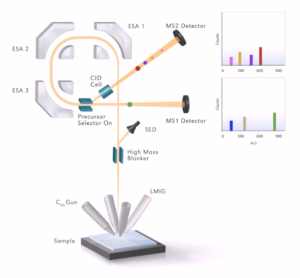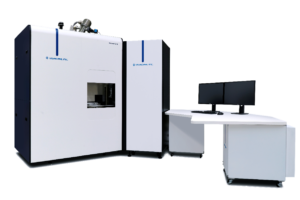♦ Nano-TOF 3 TOF-SIMS | Patented TRIFT mass spectrometer with superior sensitivity
Table Of Contents
How does TOF-SIMS work?
Time-of-Flight Secondary Ion Mass Spectrometry (TOF-SIMS) is an analytical technique used to investigate the chemical composition of solid surfaces with high sensitivity and spatial resolution. It involves bombarding a sample’s surface with a primary ion beam, which leads to the ejection of secondary ions from the sample. These secondary ions are then analyzed based on their time-of-flight to a detector, allowing for the determination of their mass-to-charge ratios.
Here’s a technical summary of how TOF-SIMS works:
- Primary Ion Bombardment: A focused primary ion beam is directed onto the surface of the sample. The primary ions typically have high kinetic energy and are selected based on the specific requirements of the analysis. The impact of these primary ions causes the ejection of secondary ions, neutrals, and electrons from the sample’s surface.
- Secondary Ion Emission: As a result of the primary ion bombardment, secondary ions are sputtered from the sample’s surface. These secondary ions carry information about the chemical composition and molecular structure of the surface. The ejected secondary ions can be both positively and negatively charged, and they cover a wide range of masses.
- Ion Extraction and Acceleration: A set of electrostatic lenses extracts the secondary ions from the sample’s surface and accelerates them into a flight tube. The primary goal is to ensure that ions with the same energy leave the sample surface and reach the detector simultaneously.
- Time-of-Flight Analysis: In the flight tube, the secondary ions travel a certain distance to reach the detector. The time taken by the ions to travel this distance depends on their mass-to-charge ratio (m/z). Lighter ions will travel faster than heavier ions, as they experience less resistance due to their higher velocity. A time-of-flight analyzer measures the time taken by the ions to reach the detector.
- Mass Calculation: Using the known distance between the sample and the detector and the measured flight time, the mass-to-charge ratio (m/z) of the ions can be calculated using the equation: m/z = (2 * E * t^2) / (L^2), where E is the accelerating voltage, t is the flight time, and L is the distance between the sample and the detector.
- Mass Spectrum: The resulting mass spectrum is a graph that displays the intensity of the detected ions as a function of their mass-to-charge ratio (m/z). Peaks in the mass spectrum represent different chemical species present on the sample’s surface. By analyzing the mass spectrum, researchers can identify elements, molecules, and fragments, gaining insights into the surface’s chemical composition.
TOF-SIMS provides high spatial resolution, making it suitable for analyzing features at the micrometer and nanometer scales. It is used in various fields, including materials science, surface chemistry, biology, and semiconductor analysis, to investigate surface composition, contamination, and molecular interactions. However, TOF-SIMS can cause surface damage due to the primary ion bombardment, and careful optimization is required to minimize this effect.
Why use TOF-SIMS?
Time-of-Flight Secondary Ion Mass Spectrometry (TOF-SIMS) is a versatile and powerful analytical technique that offers several advantages, making it a valuable tool in various scientific and industrial applications. Here’s a summary of why one would use TOF-SIMS:
- Surface Sensitivity: TOF-SIMS excels at analyzing the chemical composition of a material’s surface with exceptional sensitivity. It can detect trace amounts of elements, isotopes, and molecular species present on the surface, making it useful for investigating surface contaminants, thin films, and interfaces.
- Chemical Mapping: TOF-SIMS provides spatially resolved chemical maps that reveal the distribution of elements and molecules across a sample’s surface. This is invaluable for studying heterogeneous materials, identifying localized chemical variations, and understanding surface reactions and processes.
- Molecular Information: TOF-SIMS provides detailed molecular information about the surface composition. It can identify specific compounds, fragments, and functional groups present on the surface, aiding in the characterization of organic and inorganic materials.
- Elemental Analysis: TOF-SIMS can accurately determine the elemental composition of a surface, including the presence of isotopes. This information is crucial for understanding material properties and potential sources of contamination.
- Depth Profiling: TOF-SIMS can perform depth profiling, which involves analyzing the composition of a sample as a function of depth. This is useful for investigating layered structures, coatings, and interfaces.
- High Spatial Resolution: TOF-SIMS offers high lateral resolution, allowing researchers to study features at the micrometer and nanometer scales. This is particularly important for analyzing small particles, nanoparticles, and microstructures.
- Surface Chemistry Studies: TOF-SIMS is widely used for surface chemistry studies, enabling researchers to understand adsorption, desorption, chemical reactions, and surface modifications.
- Materials Characterization: TOF-SIMS is employed in various fields, including materials science, semiconductor industry, environmental science, biotechnology, and forensic analysis. It aids in quality control, failure analysis, and the development of new materials.
- Isotope Ratio Measurements: TOF-SIMS can measure isotope ratios with high precision. This is valuable for applications like geology, archaeology, and environmental studies.
- Non-Destructive Analysis: While TOF-SIMS involves ion bombardment, it can still be used relatively non-destructively when compared to some other techniques like traditional SIMS. Careful optimization can minimize sample damage.
Despite its advantages, TOF-SIMS also has limitations, including potential sample damage due to ion bombardment, limitations in quantitative analysis, and challenges in handling insulating samples. Researchers must consider these factors when deciding if TOF-SIMS is the appropriate technique for their specific analysis needs.

Applications for TOF-SIMS
Semiconductor Industry Quality Control and Failure Analysis
In the semiconductor industry, TOF-SIMS plays a critical role in ensuring the quality and reliability of integrated circuits and microelectronic devices. It is used for quality control during the manufacturing process and for failure analysis when issues arise. TOF-SIMS can detect and identify minute traces of contaminants, dopants, and impurities on the surfaces of semiconductor wafers. By providing detailed chemical information about surface composition, TOF-SIMS helps semiconductor manufacturers identify defects, assess the effectiveness of thin film deposition processes, and verify the integrity of materials used in chip fabrication. This capability aids in optimizing device performance and ensuring that electronic components meet industry standards.
Biomaterials and Biomedical Research
In biomaterials and biomedical research, TOF-SIMS offers insights into the chemical composition of biological samples at the nanoscale. Researchers use TOF-SIMS to study interactions between cells and materials, investigate drug delivery mechanisms, and assess the biocompatibility of biomaterials. TOF-SIMS enables the analysis of tissue sections, cells, and biomaterials to understand the distribution and composition of lipids, proteins, and other molecular species. This information is crucial for advancing our understanding of cellular responses, optimizing drug delivery strategies, and designing biocompatible materials for various medical applications.
Surface Analysis in Materials Science and Coatings
TOF-SIMS is a versatile tool for characterizing the chemical composition of surfaces in materials science and coatings research. Researchers use TOF-SIMS to gain insights into surface modifications, coatings, and thin films. It aids in understanding adhesion properties, evaluating coating uniformity, and identifying contaminants or impurities on surfaces. In materials science, TOF-SIMS assists in optimizing surface treatments to enhance material properties and performance. The technique’s ability to provide detailed information about surface chemistry helps researchers design and engineer materials with specific surface functionalities, making it a valuable asset for industries ranging from automotive coatings to advanced materials development.

